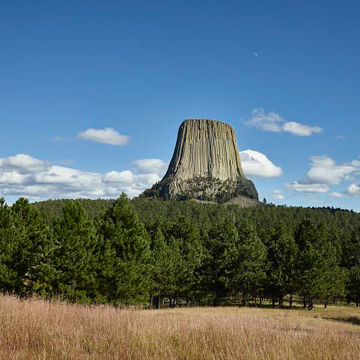As the United States’ first national monument, Devils Tower has a historical lineage that predates European-American encounters with the site. Known to the Oceti Sakowin as Mato Tipila Paha, this igneous butte rises 1,267 feet, a massive vertical outcropping in the midst of Wyoming’s Black Hills region. Devils Tower is composed of smooth, upright rock columns, often with diameters of up to eight feet, and fitted together with complex columnar jointing. The butte was formed 50 to 60 million years ago by an igneous intrusion, when magma pushed through sedimentary stone and cooled. Wind, water, and snow erosion have combined to produce the strikingly austere, vertical form of the Devils Tower today. It is composed of phonolite porphyry rock, the uniformity of which suggests that the intrusion occurred as a single event. There is still some debate as to how exactly this geologic activity occurred. Some geologists have suggested that the Tower was a laccolith; others, however, have argued that it represents a remnant of an extinct volcano.
It is not just the appellation, Devils Tower, that suggests something of the built environment, but also the formal features of the rock—its stark verticality—that seems to intimate a manmade quality. And, to a significant degree, Devils Tower has played a critical role in shaping the built, spatial, and folkloric environments of native tribes, many of which ascribe spiritual and ceremonial importance to the site. It is for this reason that the site has been designated a “Traditional Cultural Property” by the National Park Service, in light of its “association with the ideology, encoded beliefs, rituals, and/or sacred narratives of several Native American tribes.” These affiliated groups include Northern Plains groups such as the Lakota, the Arapahoe, Cheyenne, Shoshone, and the Crow. Each tribe has a narrative tied to the site, and the variation in the names ascribed to the rock—from the Araphoes’ “Bear’s Tipi” to the Cheyenne’s “Bear Lodge”—suggests the subtle nuances across groups.
The National Park Service has recorded several oral histories associated with Devils Tower. The Crow, for example, tell of two girls who fled a large bear, only to have the Great Spirit grow a massive rock beneath the two to protect them from the pursuing animal, leaving only the bear’s claw marks on the rock face today. The Kiowa tell a similar story, in which seven girls beg the Rock to “take pity on us, rock save us!” from bears, and the resultant butte grew so high and fast that it pushed the girls into seven stars above it.
Throughout the latter half of the nineteenth century, Plains Indians struggled—and failed—to protect their sacred site and the surrounding land against the encroachment of white settlers. The 1868 Fort Laramie Treaty created the Great Sioux Reservation, a body of land that was truncated by another treaty in 1876, which finally allocated the Black Hills—including Mato Tipila Paha—into the hands of the federal government. Under the 1906 Antiquities Act, President Theodore Roosevelt named the site and a surrounding 1,300 acres as the country’s first national monument.
Today Devils Tower is a destination for rock climbers, a heritage dating back to Willard Ripley and William Rogers’s initial ascent in the 1890s; the duo’s 1893 ladder is still strung along the flank of the rock face. There are several historic structures on the property as well which pertain to the Euro-American legacy of tourism and recreation at the site. These date from the construction of a Civilian Conservation Corps (CCC) camp in 1935, with several extant log structures that are currently listed on the National Register of Historic Places: a Ranger Office, a Visitor Center, an Entrance Station, and the Fire Hose House. All four structures exemplify the National Park Service’s early aesthetic propensity for a “rustic” brand of architecture meant to harmonize service buildings with the surrounding environment. The CCC likewise played a role in building roads, trails, and picnic areas and wiring sites for electricity.
Devils Tower remains a site of contemporary ceremonial practice, particularly during June’s summer solstice, when Mato Tipila Paha operates as the last stage in the Oceti Sakowin’s annual ceremonial passage; other group rituals include sweat lodges and sun dances, as well as the tying of prayer clothes and flags along adjacent trees. Considering such a natural, earthen feature from an architectural perspective may seem misplaced given western scholarship, but it is critical in the context of the built and spatial worlds of Native Americans, for in many ways the Devils Tower operates as a space-forming and space-making object, guiding the centuries-old movement patterns of Plains Tribes to and from the site itself.
Devils Tower is maintained by the National Park Service and is open year-round. Visitors can partake in camping, climbing, and hiking, and can access the Visitor Center, which also houses the Devils Tower Natural History Association.
References
Hill, Karen Lone. "Devils Tower National Monument, WY: Mato Tipila Paha—The Hill of the Bear's Lodge." In American Indian Places: A Historical Guidebook, edited by Frances H. Kennedy. New York: Houghton Mifflin, 2008.
Jenkins, Mark. "Devil's Tower, Sacred Space." Virginia Quarterly Review89, no. 1 (Winter 2013): 232–37.
McCoy, Kathy. “Devils Tower National Monument Multiple Property Submission.” National Register of Historic Places, 2000. National Park Service, U.S. Department of the Interior, Washington, DC.
National Park Servce. Environmental Assessment/General Management Plan/Development Concept Plan: Devils Tower National Monument. U.S. Department of the Interior, Washington, DC, November 1985.
National Park Service. “First Stories: Devils Tower.” Accessed 9 June 2017. https://www.nps.gov/deto/learn/historyculture/first-stories.htm.
National Park Service, “Geologic Formations: Devils Tower.” Accessed 9 June 2017. https://www.nps.gov/deto/learn/nature/geologicformations.htm.
Rogers, Jeanne. Standing Witness: Devils Tower National Monument.Devils Tower National Monument, Wyoming: National Park Service, U.S. Department of the Interior, Washington, DC, 2007.








